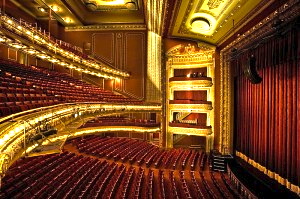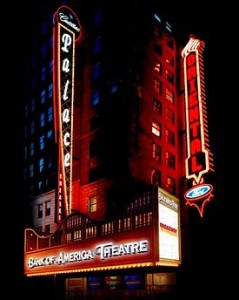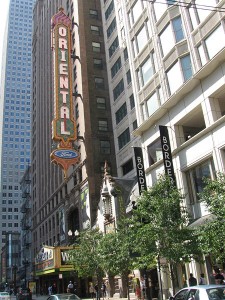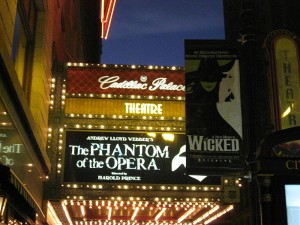Broadway In Chicago

Broadway History: Ziegfield
 Photo collage of Broadway in Chicago marquees.
Photo collage of Broadway in Chicago marquees.
Broadway In Chicago is a theatrical production company. It was formed in July 2000 by the Nederlander Organization to present touringBroadway productions in Chicago and to operate three theaters in downtown Chicago.
Theaters
Broadway In Chicago operates in five venues in downtown Chicago including The Bank of America Theatre (18 W. Monroe St.), Ford Center for the Performing Arts Oriental Theatre (24 W. Randolph St.), Cadillac Palace Theatre (151 W. Randolph St.), the Auditorium Theatre (50 E. Congress Pkwy.), and the Broadway Playhouse at Water Tower Place (175 E. Chestnut St.)
 Auditorium of the Bank of America Theatre.
Auditorium of the Bank of America Theatre.
The Bank of America Theatre opened as the Majestic Theatre in 1906. It was Chicago’s first million-dollar-plus venue and Chicago’s tallest building at the time. The Majestic Theatre closed during the Great Depression and was shuttered for 15 years however, most of the original design was retained when the theatre was remodeled and then reopened in 1945.
The Bank of America Theatre has hosted pre-Broadway world premieres Monty Python’s Spamalot and Cyndi Lauper’s Kinky Boots. The Bank of America Theatre featured a two and a half year run of the musical Jersey Boys that closed in January 2010.
Ford Center for the Performing Arts Oriental Theatre
 The Oriental Theatre in downtown Chicago.
The Oriental Theatre in downtown Chicago.
The Oriental Theatre opened on May 8, 1926. This theatre was designed by George L. and Cornelius W. Rapp for the theatre managers Balaban and Katz.
In 1930, during a record-breaking week, as many as 124,985 patrons visited the Oriental Theatre to see the hit film “Flight”. Management changed hands several times in the subsequent decades, but the Oriental Theatre continued to feature films until the early 1970s, when the M&R Amusement Company briefly presented live performances by artists such as Stevie Wonder, Gladys Knight and the Pips and Little Richard.
The theater soon fell into disrepair. In an effort to preserve the theatre, it was added to the Federal National Registry of Historic Places in 1978, however the building continued to crumble. The Oriental Theatre was closed to the public in 1981, and the site was considered for a two-story, 50,000-square-foot (4,600 m2) shopping mall and a 1,600 seat cinema. In 1996, The Chicago Mayor, Richard M. Daley, announced that the Oriental would be restored to its original grandeur for the presentation of live stage musicals by Livent, Inc. The Oriental Theatre was renamed the Ford Center for the Performing Arts in 1997, and in October 1998 the restoration of the theatre was completed. The Ford Center for the Performing Arts served as home to an open run ofWicked from June 2005 to January 2009.
 The Cadillac Palace Theatre is located in the Chicago Loop area.
The Cadillac Palace Theatre is located in the Chicago Loop area.
The Palace Theatre opened in Chicago on October 4, 1926 and was designed by the Rapp Brothers. The theatre’s distinctive characteristics include a lobby richly appointed in large decorative mirrors and breche violet and white marble, which sweep majestically through a succession of lobbies and foyers.
The theatre originally opened as the flagship of vaudeville’s Orpheum Circuit, and among the stars believed to have played at the Palace in its early years were Jimmy Durante, Mae West, Jack Benny, Sophie Tucker and Bob Hope. Despite the popularity of Vaudeville’s acts, audiences in the late 1920’s and early 1930’s had begun to lose interest in vaudeville, and in 1931 the theatre was converted into a movie palace. Initially, the Palace presented films with live stage shows, and then eventually showed only movies. Movie audiences began to stay at home to watch television in the 1950s, and theatre managers, hoping to attract larger audiences, tried to book occasional tour companies of Broadway shows, such as Gentlemen Prefer Blondes with Carol Channing, Guys and Dolls with Vivian Blaine, and The King and I with Yul Brynner and Patricia Morison.
During the late 1950’s, the Palace became equipped to show films in Cinerama. In the mid-1970’s, management of the Bismarck Hotel transformed the Palace into a banquet hall, removing all the seats in the orchestra and leveling the stage with the floor. The Palace, which was renamed the Bismarck Theatre in 1984, was converted into a rock venue. It was used sporadically during the 1990s however, in 1999 the Bismark Theatre was completely restored for live theatre and was renamed the Cadillac Palace Theatre.
The Cadillac Palace opened with the premiere of Elton John and Tim Rice’s Aida and since then, has been the home to several pre-Broadway hits including The Producers and Mamma Mia! as well as long-run engagements of The Lion King and The Color Purple.
Broadway In Chicago and Auditorium Theatre of Roosevelt University formed a long-term alliance that allows Broadway In Chicago the theatrical rights to book the Auditorium Theatre.
The Auditorium was opened in 1889 by architects Louis Sullivan and Dankmar Adler. The Auditorium building was the first multi-purpose building incorporating a hotel, offices and retail spaces along with the theatre, and one of the first public buildings to use electric lighting and air conditioning.
Broadway Playhouse at Water Tower Place
Broadway In Chicago and the Water Tower Place shopping center announced the addition of a new venue, the Broadway Playhouse at Water Tower Place, 175 E. Chestnut Street. Broadway In Chicago has entered into a long-term agreement with General Growth Properties (owner and manager of Water Tower Place) that will allow the theatre, formerly known as the Drury Lane at Water Tower Place, to re-open as the Broadway Playhouse at WaterTower Place.

